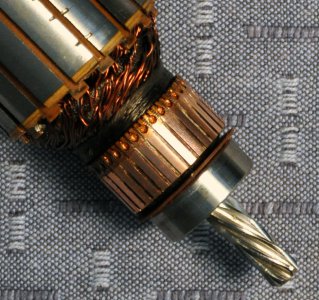- Joined
- Nov 16, 2011
- Messages
- 280
My Bridgeport's Servo brand type 70 power feed is running very slowly lately. Rapids are about 1/2 of what they've previously been and dial speeds are slow too. I know the type 70 is obsolete, but it's been working great for the last 10 years and I'm not about to replace it.
I can move the table by hand with no problem; handles spin nice and freely.
I removed the power feed and totally cleaned the leadscrew with solvent and re-lubed with fresh oil. I also pumped a ton of fresh oil into the table ways. Like I said, the table moves fine manually.
So I took apart the servo drive unit and cleaned everything inside and out. I used electrical contact cleaner to totally clean the armature and coil. I also cleaned and lubed the upper and lower gear assemblies. With the servo still removed from the table, I ran the motor through its speed range and rapid too. That worked well, sounded great and was moving nice and fast.
I then put everything back together on the mill table and it still seems slow. A little better than it was before the cleaning, but nothing like it should be.
I should mention that I replaced the motor brushes last year and the drive was working fine after that. During my cleaning, I inspected the brushes and they looked fine. The servo unit does not run hot or anything obvious and the machine does not get used very much; maybe 4 hrs per month.
So, where should I be looking for the culprit?
I can move the table by hand with no problem; handles spin nice and freely.
I removed the power feed and totally cleaned the leadscrew with solvent and re-lubed with fresh oil. I also pumped a ton of fresh oil into the table ways. Like I said, the table moves fine manually.
So I took apart the servo drive unit and cleaned everything inside and out. I used electrical contact cleaner to totally clean the armature and coil. I also cleaned and lubed the upper and lower gear assemblies. With the servo still removed from the table, I ran the motor through its speed range and rapid too. That worked well, sounded great and was moving nice and fast.
I then put everything back together on the mill table and it still seems slow. A little better than it was before the cleaning, but nothing like it should be.
I should mention that I replaced the motor brushes last year and the drive was working fine after that. During my cleaning, I inspected the brushes and they looked fine. The servo unit does not run hot or anything obvious and the machine does not get used very much; maybe 4 hrs per month.
So, where should I be looking for the culprit?
Last edited:

